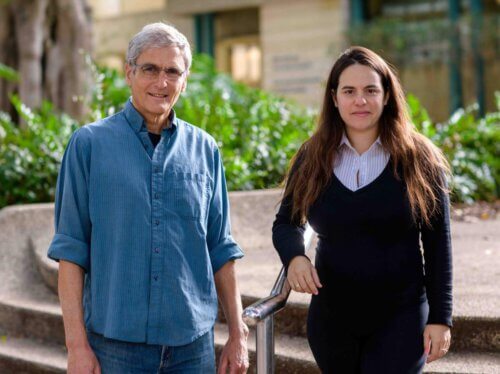In recent years, a perception of vision as a cyclical feedback process that occurs in a closed circuit has been taking shape: the eyes scan the world, the brain receives the visual information - and at the same time directs their movements according to this information. A new study by Weizmann Institute of Science scientists offers significant reinforcement for this approach
"I am a camera that narrowed open, only perceives, records, without thinking" (Farewell from Berlin, Christopher Isherwood. Translation: Shaul Levin)
It doesn't matter if we are focused on the screen, admiring the view or just staring into space, our eyes are not inferior for a moment. Even when we are not aware of their movements, they constantly scan the environment with microscopic movements and thus enable the act of vision. In the past, it was common to think that, similar to photography, vision is also a one-way process: the lens of the eye perceives differences in light intensity, transmits this information to the retina, and from there it passes to the brain. But in recent years, a perception of vision as a cyclical feedback process that occurs in a closed circuit has been taking shape: the eyes scan the world, the brain receives the visual information - and at the same time directs their movements according to this information. New research of Weizmann Institute of Science scientists offers a significant boost to this approach.
The research conducted in the laboratory of Prof. Ehud Ahisher From the neurobiology department, led by research student Liron Grover, clarifies what distinguishes the human vision system, which operates interactively, i.e., in a closed circuit, and computer vision that relies on cameras. This difference may explain why human vision still surpasses robotic vision, especially in poor visibility conditions, and how it may be possible in the future to close the gap between them. Furthermore, understanding how exactly our vision is affected by eye movements will perhaps allow us to develop ways to overcome vision problems, for example, through the development of training methods that take these movements into account.

Gruber and Aisher examined two main types of eye movements: a quick eye jump called a "saccade" and a scanning action called a "drift", which comes after each saccade, and is usually ten times slower or more and lasts on average between three and four tenth of a second. It is now known that saccades work in a closed circuit - the brain directs them based on the visual input. On the other hand, it was customary to treat eye wandering as a one-way process in an open circuit: after the saccade directs the eye to the focus of interest, the wandering, so to speak, is a kind of photography that is not affected by what the eye sees, similar to a camera that records "without thinking" what is placed in front of it.
The institute's scientists designed experiments designed to test if this is indeed how the eye movements work. The research participants were asked to observe different geometric shapes displayed on a computer screen of different sizes and under different conditions: normally or through a virtual tunnel that hid all the details except for a small opening. The participants wore helmets with cameras that recorded exactly what they were looking at and followed their eye movements - and in particular the speeds of the eye movements and their trajectories. The hypothesis was that if the eye does "photograph" unidirectionally, the migrations should not be affected either by the viewing conditions or by the observed details. Conversely, if the eye movements are part of a closed-loop interactive process, they are expected to change both according to the visual input and over time, as the eye adapts to the task.
The experiments showed that, contrary to popular opinion, eye movements operate distinctly in a closed circuit. For example, the migrations slowed down when the eyes looked at more complex details that "created" more interest for them - and their routes also changed: they did not migrate in one direction, but wandered more around the observed area. Gradually, within a few tenths of a second, the average migration speed decreased to a speed that was typical for the visual conditions. The balance between the speed of the migration and its trajectory was dictated by the vision conditions and the size of the object, apparently in a way that adapted the visual information acquired through them to the visual task. "None of this would have happened if the migrations worked unidirectionally like a camera," says Grover. "In fact, the findings show that not only saccades, but also migrations operate in a closed circuit and continuously respond to everything the eye sees - and this already means that the entire visual system works in a dynamic and interactive manner."
"The brain not only receives visual information in a one-way way but, in a certain sense, becomes part of the observed reality," explains Prof. Ahisher and adds: "This conclusion contributes its part to a philosophical discussion: is vision in particular, and our senses in general, a direct or indirect process ? I mean, do we feel reality in an immediate and unmediated way, or are we destined to always see the world indirectly through intermediary representations? Our findings indicate that the brain constantly strives for a direct and unmediated sensation of the outside world."
More of the topic in Hayadan:
